The ‘secrets’ behind Red Bull’s F1 ground effect advantage… and the Lotus that started it all
In 1977, Lotus stole a march on its Formula 1 rivals with its ground effect design. As Mark Hughes sets out, there are clear parallels between Colin Chapman’s foresight and what is happening at Red Bull today

DPPI , Getty Images
Colin Chapman was very irritated. He was a day late arriving at the 1977 Belgian Grand Prix and during Friday qualifying, in Chapman’s absence, Mario Andretti had lapped 1.54sec faster than anyone else. Chapman took Andretti to task for revealing the extent of the car’s advantage. Everyone would be wanting to find out the secret of the Lotus 78 now, he scolded.
Its secret, of course, was ground effect – a secret that could only be implied by the Lotus’s unusual shape but which would have required a good look at its internals to understand. So it was a secret that took a while to be decoded. In the right circumstances, such as those of Zolder where Andretti set that resounding pole, the 78 was in a different league to its 1977 rivals. The next big technological leap in F1’s evolution had just been taken. As such, a grid-full of copies may have been expected for 1978. Yet it didn’t happen like that. Tony Southgate – who had been part of the Lotus 78 programme – created the ground effect Shadow DN9 and Arrows FA1 (the same design for two different teams). Harvey Postlethwaite gave us the distinctive radiator-on-the-cockpit-front Wolf WR5. And that was it. They were the only two ground effect designs competing with the title-winning Lotus 79 in 1978. No other team had gone near ground effect despite its obviously enormous potential and despite watching the Lotus’s performances through ’77.

Mario Andretti set a blistering pace at Zolder in 1977 in the Lotus 78, but Colin Chapman was far from happy
Phipps/Sutton
Ferrari and Brabham were thwarted anyway by the unsuitable shape of their flat-12 engines, but even so Ferrari’s Mauro Forghieri said at the time that he was unconvinced that ground effect was even real! Brabham’s design chief Gordon Murray recalled: “No one knew exactly what they’d harnessed. We were all still trying to understand it.” Others – including Williams’ Patrick Head – said they wished to get a fuller understanding of it before committing to such a design (which a couple of years later would materialise as the FW07). It wasn’t until 1979, two years after Lotus had shown the way, that we saw a grid full of ground effect cars.
Fast-forward to 2022, the first year of the new ground effect regulations (after 39 years of enforced flat-bottomed cars) and the Red Bull RB18 won all but five of the 22 races. It was clearly more effective than the other cars, but what was the design secret conferring such an advantage? That wasn’t immediately obvious. The waters were further muddied by the fact that its two closest rivals – the Ferrari F1-75 and Mercedes W13 – were visibly very different. But there were other, slower cars which looked superficially much like the Red Bull.
Still, it was confidently expected that into 2023, as teams full of clever design and engineering brains had been given a chance to observe and learn from the RB18, Red Bull’s advantage would at least be reduced. Instead, it increased. To the extent that the RB19 set new records of achievement in world championship history. In winning the Italian Grand Prix, Max Verstappen extended the consecutive victory record for a driver to 10 and for a team to 15. The RB19 was proving literally unbeatable.
Lotus 78 aero secrets

The underside of the radiators concealed within the Lotus 78’s sidepods helped form the venturi shape (beneath the yellow shaded area). The choke point nearest the ground, in trying to constrict the airflow, increases its speed which reduces the pressure, while the diffuser at the rear progressively returns the airflow to atmospheric pressure, amplifying the low-pressure effect further forward while preventing the high drag which would otherwise be induced at the rear where the high-pressure over-body flow meets with the low-pressure underbody flow. The steeper the diffuser ramp, the faster the air rushes through the choke point. Sealing off the sidepod with sliding skirts allowed this lower pressure to be sealed, effectively sucking the car into the road.

There are parallels in how long it took rivals to understand and catch up on Lotus’s breakthrough in the ’70s and Red Bull’s advantage in the first two years of the new ground effect formula 2022-23. But the factors driving those two scenarios are quite different.
Lotus in 1977 entered a new dimension, harnessing some strange new force. It was just physics, of course, but may as well have been magic to the others. Such things were possible in an F1 era of unlimited technical freedom, albeit limited resource. The very opposite applied in Red Bull’s era – very limited technical freedom but vast financial resource.
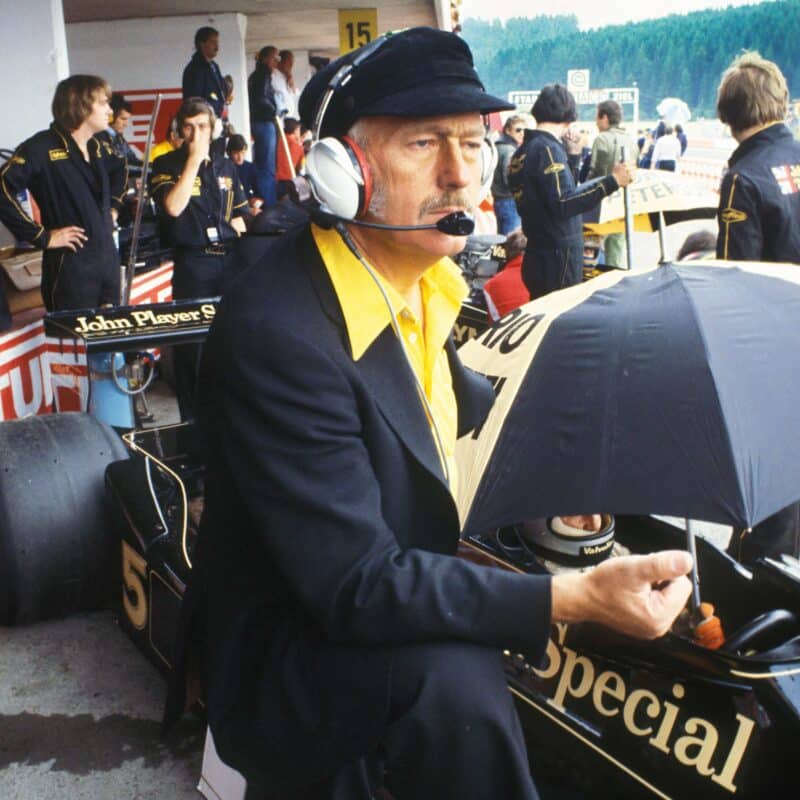
Chapman with stopwatch times Andretti’s practice at the 1978 Austrian GP
Grand Prix Photo
So while Peter Wright and Chapman were able to blue-sky-think their way to a totally new type of car, even redefining what an F1 car was, four decades later the Adrian Newey-led Red Bull technical team were operating within regulations defining virtually every dimension. The key to an advantage in such an environment was finding and unpicking a small thread leading to a vast hidden cavern of performance. Whereas in Chapman’s day the caverns were wide open, just waiting for someone with the imagination to walk into them.
Talking with Wright for a Motor Sport piece in 1998, he recalled, “The work really started when I was at BRM in the late ’60s with Tony Rudd. We’d started to build a wing car there but it didn’t have skirts and probably wouldn’t have worked very well.” But the venturi tunnels within the floor were there.
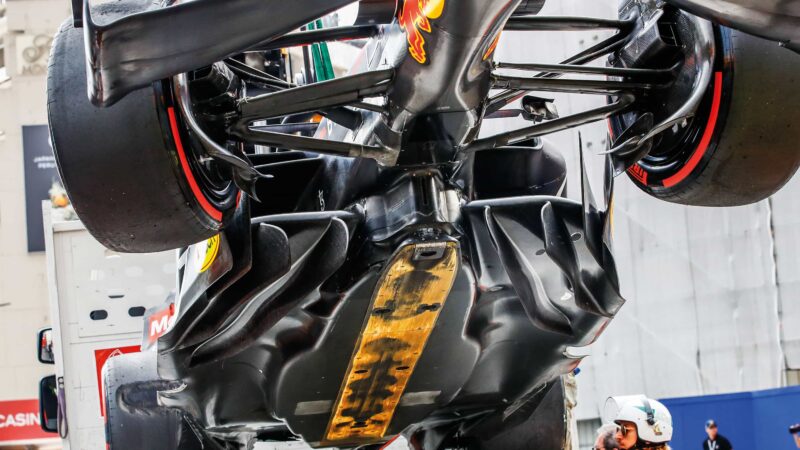
Sergio Pérez’s crash at Monaco in 2022 let rivals study the underside of the Red Bull
DPPI
When Chapman tasked Wright and Rudd to go back to fundamentals in the conception of the 78, they revisited the idea they’d looked at with BRM. How to seal off the sides of the tunnels to create a powerful pressure difference was going to be key. “We were a bit nervous about what we’d be allowed to run,” recalled Wright, “and so we first tried it with brushes. They didn’t really work. But we found a precedent for running skirts and they were much more effective.” When the moving belt in the wind tunnel was sucked off its runners, they knew they were onto something. Allowing the skirts to slide up and down so there was always a physical seal with the road sent the downforce numbers off the scale. “The real breakthrough came when we put ceramic tips on the skirts and made them suck down instead of up by sealing all the time.”
“It was just physics, of course, but may as well have been magic”
So F1 ground effect was born. With its boxed-off sidepods connected to the ground by nylon skirts, the venturi shape within was able to create a big low-pressure zone beneath the car, sucking it down to the road. It was the season’s fastest car but lost the title through engine unreliability. Its 1978 successor, the 79, took the basic concept but moved the centre of aerodynamic pressure further back so it no longer needed a big rear wing to balance the forces generated on the front axle. Its advantage over the largely non-ground-effect opposition was enhanced and it took Andretti and Ronnie Peterson to a 1-2 in the drivers’ championship (albeit posthumously for Peterson, who died after a startline crash at Monza).
Skirted ground effect cars reached their zenith in 1980 before the governing body – alarmed at the exponential increase in cornering speeds – acted to limit ground effect, initially with a skirt ban, subsequently also a minimum ride height before finally banishing the tunnelled ground effect car altogether with the 1983 flat-bottom regulations. Nothing can be un-invented and in the following decades even the flat-bottom cars were in actuality ground effect, with floors that merged into big diffusers at the back to induce a low-pressure area beneath the whole flat surface of the floor. In place of the banned physical skirts were invisible airflow skirts, whereby vortices were created which spun down the edges of the floor to prevent the airflow going through the floor to leak from the sides.
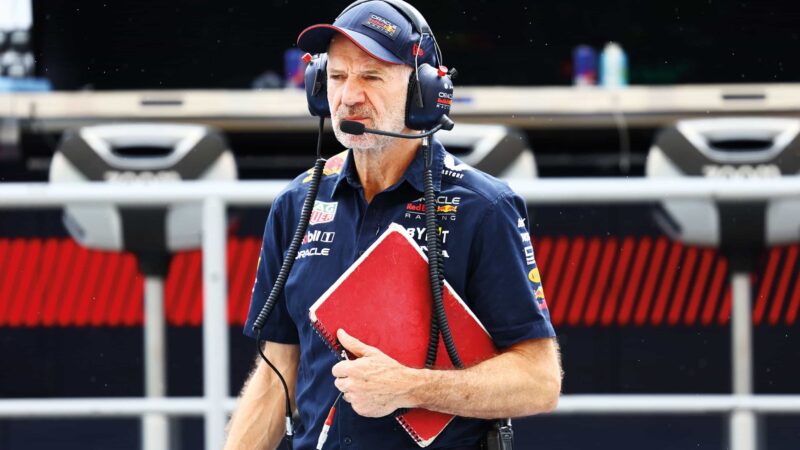
Despite the rigorous regulations of modern F1, Red Bull’s Adrian Newey saw some wriggle room – advantage Max Verstappen
Getty Images
The sidepod tunnel ground effect car made its reappearance by regulation in 2022 as F1 tried to create an aerodynamic formula in which the cars would create a cleaner wake to help aid overtaking. But this was a tunnelled ground effect car born within a vastly more regulated era, with many of the body surfaces prescribed by the rule book. When Adrian Newey first looked at these regulations he was dispirited at how they seemed to leave no room for creativity. But then he began to look a little harder. “As you dig into it more,” he said in 2022, “particularly in the area of the sidepod and floor – there’s actually a reasonable degree of freedom. More than you first think. The chassis is near enough designed for you by the regulations, the front wing quite prescriptive. Front and rear suspension, although there is some prescription on the angles, in terms of layout there’s still some freedom.” But it was the sidepod/floor/suspension combination where the Red Bull team – which as well as Newey includes technical director Pierre Waché and chief of aero Enrico Balbo – was able to carve out an invisible advantage.
RED BULL RB19 UNDERFLOOR
A look beneath the car and there’s a landscape of tunnels and archways. You can see how much more complex and sophisticated the geometry is than the Mercedes underfloor.
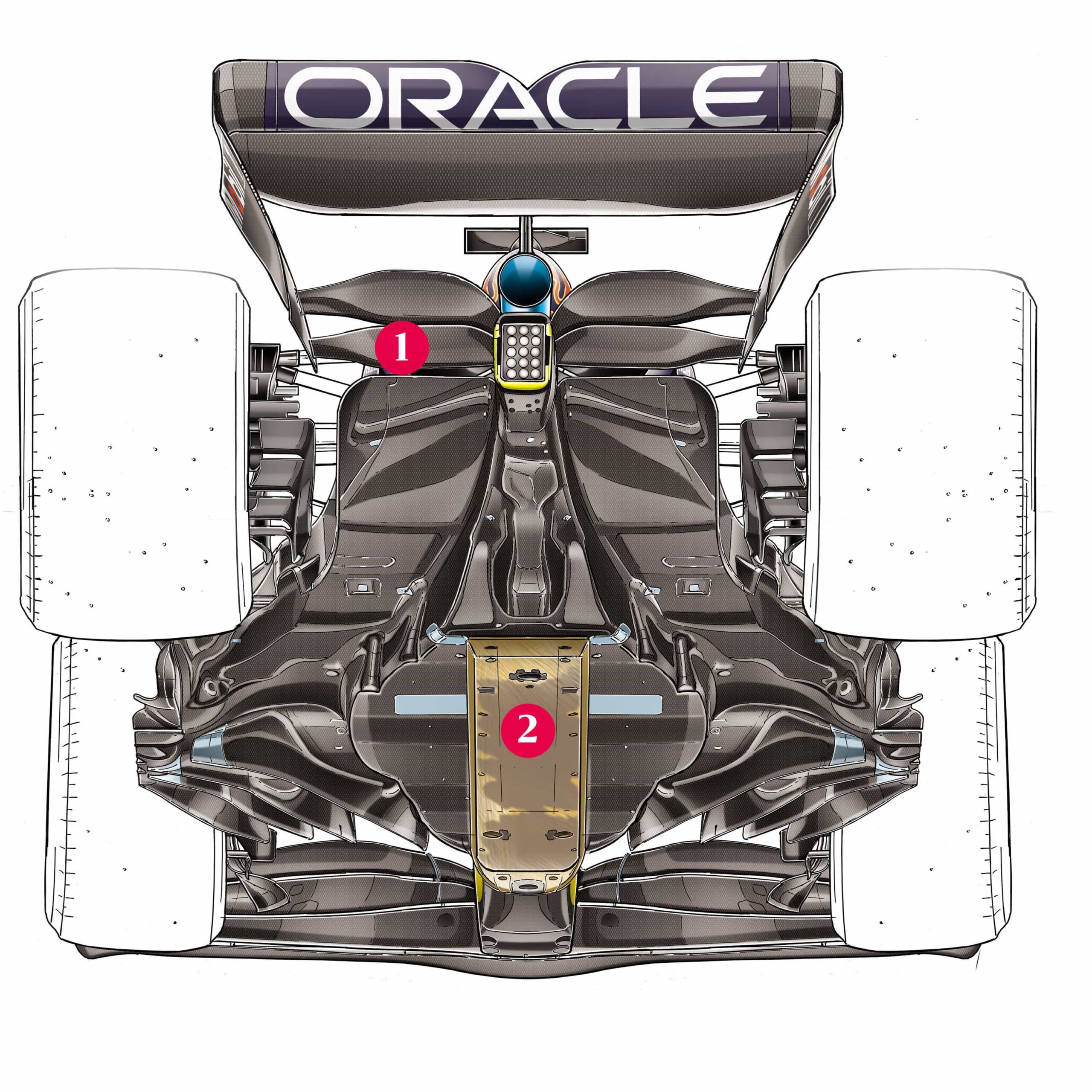
1. Twin-plane beam wing
The twin-plane beam wing in continuing the ramp angle of the tunnel’s diffuser connects up that airflow with the underside of the rear wing. This effectively increases the diffuser’s length (sucking the car down harder from beneath) and decreases the pressure on the main wing’s underside, creating a bigger pressure differential with the high-pressure flow over the wing’s upper surface (pushing the car down harder from above).
2. Central flat section
The profile of the central flat section (upon which the regulation plank is mounted) determines the varying width of the tunnels either side, along their length. This variation is to fully energise the flow through the tunnels. The tunnel diffuser is regulated much further back than on the original ground effect cars and its maximum ramp angle is also defined by regulation, limiting its potential, as does the regulation absence of physical skirts. But the flow is energised by the intricate changes in geometry of the tunnels. Those of the Red Bull are higher-roofed and more arched than rivals, giving greater resistance to porpoising and better spread of downforce through the full speed range.
MERCEDES W14 UNDERFLOOR
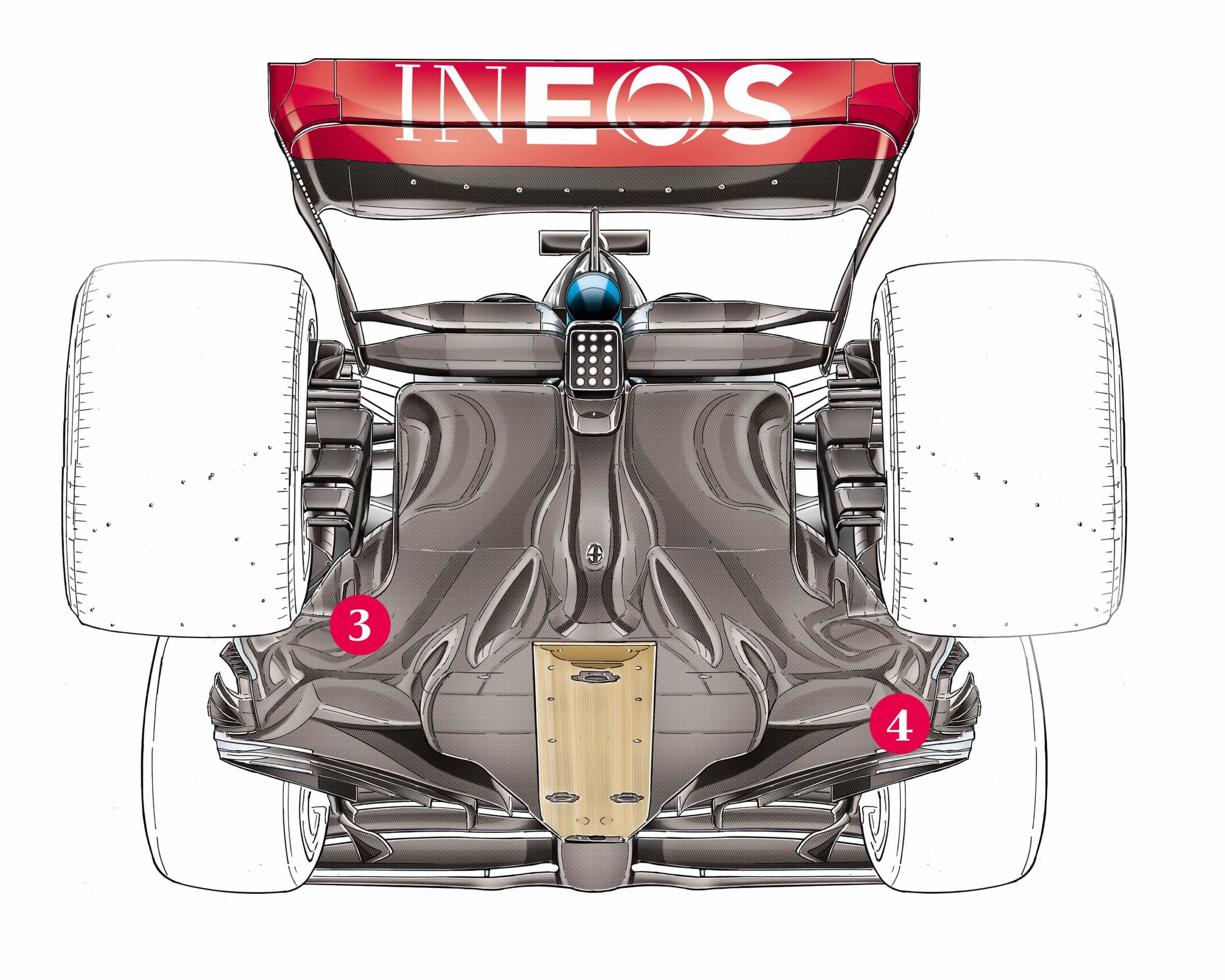
3. Tunnel roof
The W14’s tunnel roof (pre-Spanish GP update) is lower and less arched. While the lower roof just before the choke point would theoretically create more downforce, in practice the limitation of bouncing or porpoising means its theoretical limit cannot be reached.
4. Lateral vanes
The lateral vanes at the front of the floor split the airflow which has entered the tunnel inlets. Air entering the inboard vanes continues through the length of the tunnel. Air channelled by the outboard vanes is directed back outside and along the lower floor edges. This helps power-up vortices of spinning air at the outboard edge of the floor and these act as a virtual seal, doing the same job as the banned skirts in sealing off the floor and allowing it to be sucked down harder. The airflow passing along the length of the tunnel avoids the spinning vortices at the outboard edge, retaining its energy as it rushes towards the diffuser. The different arrangement of these vanes compared to the Red Bull reflects the very different front sidepod shapes.
There was nothing about the exterior shapes of the RB18 and RB19 to suggest they were radically different from, say, a McLaren or Alpine. They all featured sidepods with a heavy undercut at the front beneath which lay the tunnel inlets. The relatively slim sidepods sloped gently down to a point just ahead of the rear wheels. Yet the RB18 was in the order of 1.5sec per lap faster. When you looked at Lotus 78 and compared it to a McLaren M26 in 1977, they were explicitly, obviously, created around totally different sets of priorities. One informed by a new branch of science, the other not. Even if that science was not understood on the outside, it made sense that the new concept, so radically different in appearance, should be so much faster than the old. There was something fundamentally different. But without the resources or people to research it deeply and quickly, even the big clue of the 78’s very different appearance didn’t allow that secret to be uncovered immediately.
“The first real clue came when Sergio Pérez crashed at Monaco”
But this time around there is all the resource and personnel anyone could reasonably wish for. Yet no external clue from the shape of the car. So what is the source of Red Bull’s crushing superiority when the cars look so ostensibly similar to so many others?
The first real clue came when Sergio Pérez crashed in qualifying at Monaco in ’22 and the car was lifted high in the air by crane. That’s when everyone got their first real look at the Red Bull underfloor – and it was unlike anyone else’s, all of which looked remarkably similar with a teardrop-shaped flat central section (or ‘canoe’ as it is nicknamed) with two very low-roofed tunnels running either side. The teardrop shape of the flat central section of floor determines the width of the tunnels along their length, wide at the front, narrow in the middle, wide again at the back. The low tunnel roof would in theory maximise the low pressure and thereby downforce. But the Red Bull’s central section was not at all teardrop-shaped; instead it featured sharp profile changes to energise the tunnel airflow at specific points. The roof was arched, not square like the others, and visibly higher. It was the product of a more sophisticated understanding of the underbody airflow.
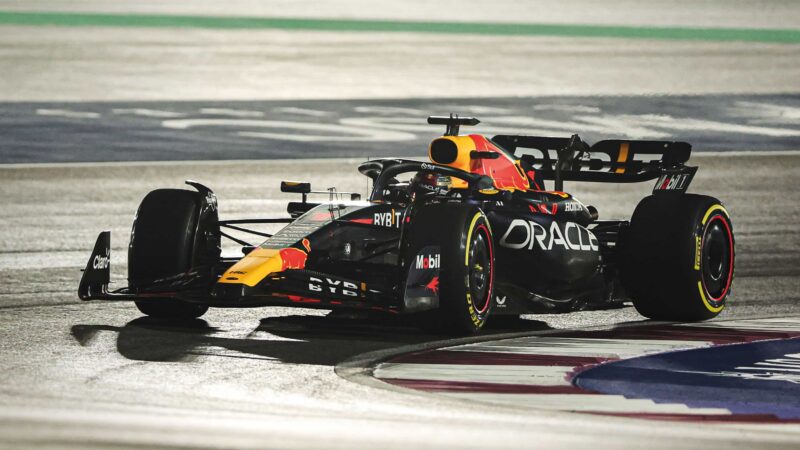
Can we expect the rest of the grid to catch up with Red Bull in 2024? Don’t bet on it…
Getty Images
If only the idealised airflow was modelled, simulation would show the common layout with the low ceiling and simple contours would create more downforce. But insert a few real world limitations and the picture alters dramatically. Teams quickly found that they could not exploit the full theoretical downforce of their floors because of the bouncing phenomenon. As the car got lower to the ground at speed the airflow at the lowest point of the floor would choke, stalling the downforce, the car would rise up in its suspension, allowing it to work again etc, all repeated at very high frequency. The only cure was to increase the rear ride height, thereby losing a big chunk of that theoretical downforce. By contrast, the high arched roofs of the Red Bull tunnels allowed the floor to keep sucking as the throat of venturi (its lowest point) was almost touching the ground. The result was a much wider spread of downforce delivery through different ride heights (cars naturally lower themselves as speed increases and rise as it reduces) and angles of roll, pitch and dive. Its peak downforce may have been lower, but it’s the spread and delivery of downforce which is more critical to lap time. The Red Bull ran a high tunnel roof with a low ride height while the others ran the opposite and the former was much superior. Coupled with a long-travel rear suspension and tight platform control from an extreme anti-dive front suspension geometry, the RB18 was a devastating tool in the hands of Verstappen.
RED BULL CHASSIS RB18 vs RB19
Look beyond the packaging of the front suspension internals to the shape of the chassis bottom beneath, red arrows. The RB19’s, below, is much more V-shaped than that of its predecessor, above. That shape is carried the length of the central section of floor and it creates more downforce-generating volume beneath the floor. In increasing the height of the undercut area between the radiator inlet bodywork and the floor edge, it also allows a more powerful propagation of vortex as the air spills down the side and therefore a faster flow along the lower body towards the rear and a stronger seal for the underfloor.
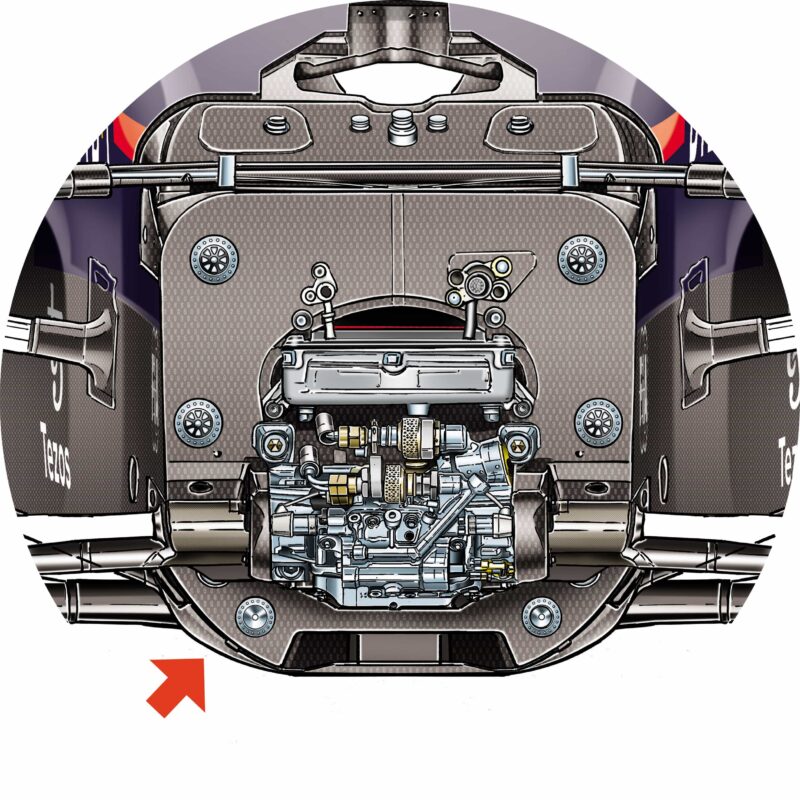
RB18
GIORGIO PIOLA
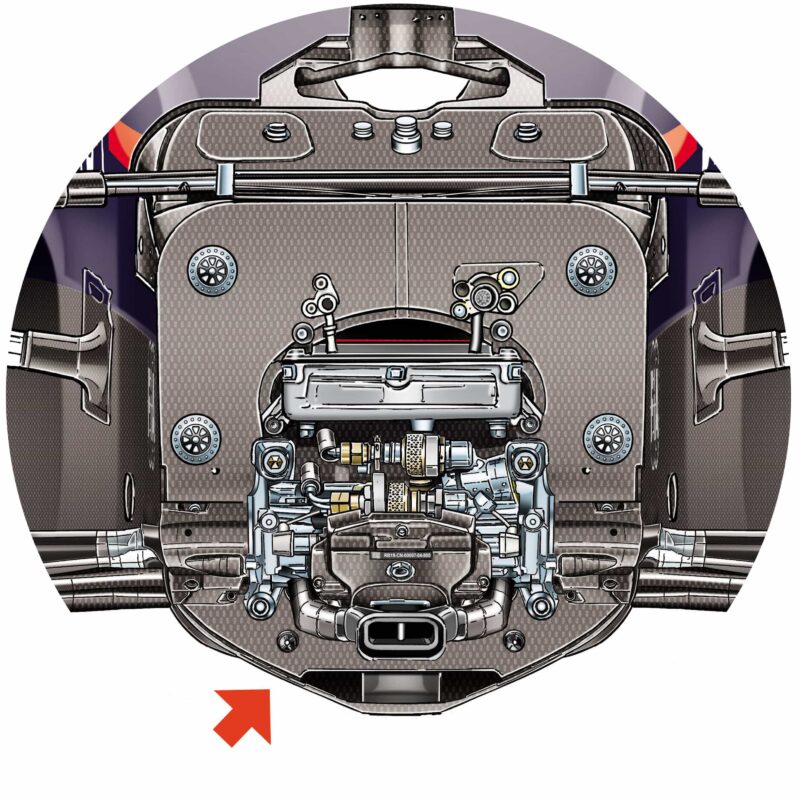
RB19
GIORGIO PIOLA
In their 2023 designs, many teams – notably Mercedes, Aston Martin and others – took inspiration from Red Bull’s stepped canoe central floor to better energise the airflow before it arrives at the venturi throat. But Red Bull had moved the game on further with its RB19.
“The RB18 was a devastating tool in the hands of Verstappen”
Looking very little different to its predecessor at a casual glance, it was in reality a totally re-engineered car retaining that great consistent downforce delivery but now with a greater peak. Red Bull did this by raising the whole cooling system up out of the way of the initial downward sweep of the tunnel (allowing it to be profiled much more aggressively) and by giving it a V-section chassis, increasing the available tunnel volume. These changes brought with them a higher centre of gravity but the aerodynamic gains more than overcame the penalty of that.
RED BULL RB16B vs RB19 COOLING LAYOUT
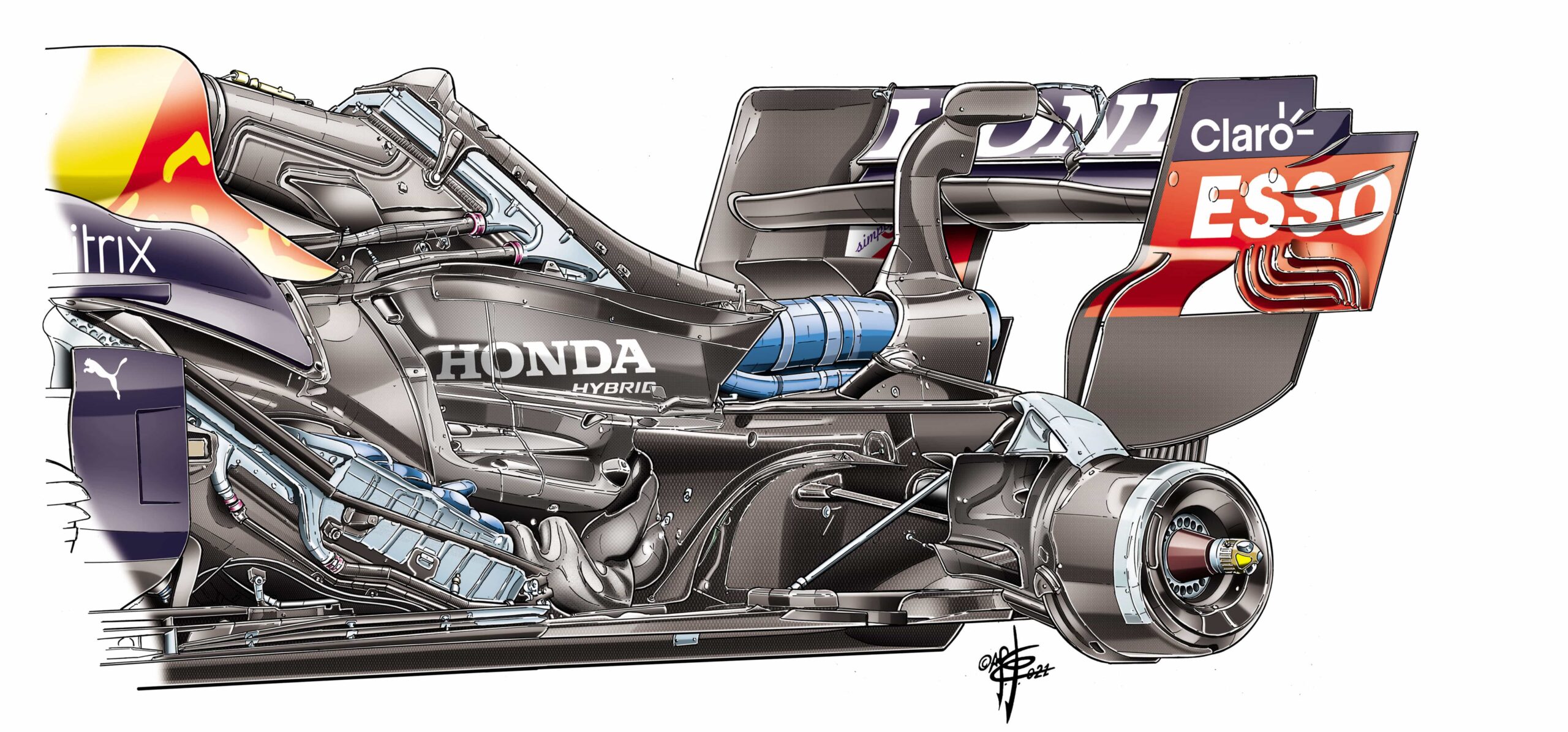
Red Bull RB16B (2021)
The final flat-bottomed car. Low-mounted lower radiator (the edge of which is seen here towards the front, in blue) helps minimises the centre of gravity height.

Red Bull RB19 (2023)
The lower radiator (now of a slimmer design) has been moved up to create more space for the contouring of the tunnels. The aerodynamic benefit will have overcome any loss from the increased centre of gravity height. The inlet plenum (behind the airbox) and the intercooler around it has been shortened and angled further downwards. This re-plumbing has enabled the exhaust primaries to be mounted lower, as can be seen by how the exhaust outlet now has to angle downwards to meet them. This will have offset the effect on the centre of gravity height at the front.
It was McLaren which seemed to be the first to understand where the RB19’s gains had originated. Its Austria update comprised a repackaged cooling system which allowed the front of the sidepod to be lifted, enabling that more aggressive tunnel shape. The gains in McLaren’s competitiveness seemed to have triggered light-bulb moments elsewhere and by the time of the Singapore Grand Prix Alpine, AlphaTauri and Alfa Romeo all turned up with similar developments.
So it may be, two years after Red Bull stole a march, the competition will be ready with designs that finally incorporate what were Red Bull’s secrets. But Red Bull may move the game on again. Which is what Lotus tried to do in 1979 with the full-length venturis of the Lotus 80. It was a disaster and scrapped after a handful of races. That’s where the historical parallels may end.
